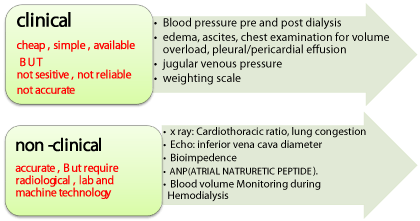
Letter to the Editor
Austin Renal Dis.2016; 1(1): 1002.
Ideal Dry Weight in Dialysis Patients are we there Yet?
Seddik A¹ and Al Alawi F²*
¹Nephrology Department, Faculty of Medicine, Ain Shams University, P.O. Box 7047-112, Cairo, Egypt
²Nephrology Division, Dubai Hospital, Dubai Health Authority, Dubai, UAE
*Corresponding author: Fakhriya Al Alawi, Nephrology Division, Dubai Hospital, Dubai Health Authority, Dubai, UAE
Received: August 23, 2016; Accepted: August 26, 2016; Published: August 29, 2016
Letter to the Editor
One of the difficult tasks to achieve in hemodialysis patients is the ideal dry weight; hence many definitions had evolved during the past few decades.
As early as Hemodialysis began; dry weight was an objective to reach during the evolving therapy. In 1967 Thomson et al, define dry weigh as reduction of BP to hypotensive levels during ultra filtration and not associated with other obvious causes [1]. During 1980th the definition have changed to a more aggressive approach states that dry weight is the weight obtained at the conclusion of a regular dialysis treatment below which the patient is more often will become symptomatic and might go into shock, such an aggressive approach have been abandoned with more rationale definitions in 1990th where again maintain normotensive without antihypertensive medications in between dialysis session marking the ideal dry weight in spite of possible salt and fluid retention [2].
In 2009, Sinha and Agarwal proposed a definition that combines subjective and objective measurements; “The lowest tolerated post dialysis weight achieved via a gradual change in post dialysis weight at which there are minimal signs or symptoms of hypo- or hypervolemia & the patient can remain normotensive until the next dialysis without antihypertensive medication” [3].
Still however some patients develop hypotension while not achieving dry weigh and manifestations of intravascular volume depletion still can occur in patients with volume overload.
Ideal Dry weight then can be achieved when patients having: Shortest post-dialysis recovery time, Least intradialytic hypotension episodes, Longest patient survival, Fewest cardiovascular and cerebrovascular events and hospitalizations, Fewest hypovolemiarelated access thrombosis, and fewest post-dialysis falls [3].
Predialysis hypertension is a major problem and escalation of antihypertensive medications is a usual approach by many nephrologists, however achieving the ideal dry weight and gradual increase in patient ultra filtration till a euovolemic status achieved play a major rule in controlling hypertension in hemodialysis patients.
On the other hand patients developing hypotension or postural drop in blood pressure post dialysis especially if symptomatic with dizziness, easy fatigability, somnolence is a strong indicator of the need to elevate dry weight to a higher target at which such symptoms and findings disappear.
Different approaches have been developed to assess the target dry weight with either clinical or non-clinical procedures as illustrated in (Figure 1).

Figure 1: The target dry weight with either clinical or non-clinical procedures.
Approach for achieving dry weight should implement a multidisciplinary team approach; including dietician, dialysis nurse and a nephrologist, all should work in proximity with the patient. Family support should be requested when necessary during patient educational sessions to achieve the target dry weight [4].
Control of interdialytic weight gain is of prime importance, salt restriction is the key for such approach, 1.2- 2gm per day of salt and fluid restriction to 1000 to 1200 ml of fluid per day will help dialysis patients in achieving their target dry weight plus controlling hypertension and avoidance of symptomatic hypotension and muscle cramps encountered during high ultra filtration rates in patients with high interdialytic weight gain. The target interdialytic weight gain should be less than 4% in the midweek sessions and up to 5% during the weekends [5].
Medical care during HD sessions aims to deliver a safe and effective treatment. It is much easier to ask this effort of the patient at the start of dialysis when he is looking for a rapid improvement. The treatment is monitored by the attending nurse in addition to a comprehensive clinical assessment aiming at prevention of the occurrence of treatment-related complications. The safe removal of excess fluid is primarily the responsibility of the dialysis team, assessment of the ideal dry weight enables the team to determine the amount of fluid required to be removed and avoids the occurrence of dialysis complications related to less or excess volume removal [6].
References
- Thomson GE, Waterhouse K, McDonald HP Jr., Friedman EA: Hemodialysis for chronic renal failure. Clinical observations. Arch Intern Med. 1967; 120: 153-167.
- Charra B, Laurent G, Chazot C, Calemard E, Terrat JC, Vanel T, et al. Clinical assessment of dry weight. Nephrol Dial Transplant. 1996; 11: 16-19.
- Rajiv A, Matthew R Weir. Dry-weight: a concept revisited in an effort to avoidmedication-directed approaches for blood pressure control in hemodialysis patients. Clin J Am Soc Nephrol. 2010; 5: 1255-1260.
- Baraz S, Parvardeh S, Mohammadi E, Broumand B. Dietary and fluid compliance: an educational intervention for patients having haemodialysis. Journal of Advanced Nursing. 2010; 66: 60-68.
- Canaud B, Lertdumrongluk P. Probing ‘dry weight’ in haemodialysis patients:‘back to the future’. Nephrology Dialysis and Transplantation. 2012; 27: 2140- 2143.
- Bradshaw W, Ockerby C, Bennett P. Pre-emptively pausing ultra filtration to minimize dialysis hypotension. Renal Society of Australasia Journal. 2011; 7: 130-134.